Historic Sanford Memorial Stadium is located at 1201 S. Mellonville Avenue in Sanford, Florida.

One block south of Sanford Memorial Stadium, at the northeast corner of South Mellonville Avenue and Celery Avenue, is the former site of Sanford Field.
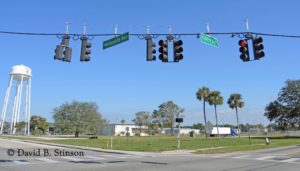
The two ballparks coexisted briefly.

Sanford Field was constructed in 1926. It included a simple, wooden grandstand and bleacher seating along third base.

The ballpark was demolished during the early 1950s and replaced, for a time, with dormitories to house players during spring training.

Today, the former site of Sanford Field is an open grass field.



According to baseballreference.com, minor league baseball was played in Sanford as far back as 1919, beginning with the Sanford Celeryfeds of the Florida State League.
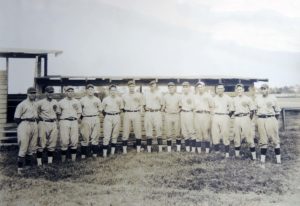
The Celeryfeds, so named because celery was a major crop grown there, played in Sanford from 1919 to 1920, from 1925 to 1928, and again in 1946.

Other Sanford team names included the Lookouts, from 1936 to 1939, the Seminoles, from 1940 to 1941, and again in 1947, the Giants, from 1948 to 1951, the Seminole Blues in 1952, the Cardinals in 1953 and 1955, and the Greyhounds, from 1959 to 1960. Major league teams affiliated with Sanford Florida State League teams, include the Washington Senators, from 1936 to 1939, and in 1959, the New York Giants, from 1948 to 1951, the St. Louis Cardinals, in 1953 and 1955, and the Kansas City Athletics in 1959.
The Washington Senators’ affiliate, the Sanford Lookouts, in 1937, included future Hall of Famer Early Wynn.

According to a Washington Post article, “[b]ecause his Aunt Sophie happened to live in Sanford, Fla., where the Chattanooga club was holding a baseball school, and because he happened to be visiting her at the time, Earl Wynn is now a bright young pitching prospect of the Nats.” “Nats Rookie Parade at Orlando Camp,” Washington Post, February 22, 1940: 20. Another notable team, the 1939 Sanford Lookouts, posted a record of 98-35, and were ranked by Minor League Baseball the 68th greatest team in minor league history.
According to a Washington Post article, “[b]ecause his Aunt Sophie happened to live in Sanford, Fla., where the Chattanooga club was holding a baseball school, and because he happened to be visiting her at the time, Earl Wynn is now a bright young pitching prospect of the Nats.” “Nats Rookie Parade at Orlando Camp,” Washington Post, February 22, 1940: 20. Another notable team, the 1939 Sanford Lookouts, posted a record of 98-35, and were ranked by Minor League Baseball the 68th greatest team in minor league history.
Exhibition games and spring training have played an important part of Sanford’s baseball history. In the 1930s, the Chattanooga Lookouts held spring training at Sanford Field, including games against its parent club, the Washington Senators. “Exhibition Baseball,” Washington Post, April 2, 1937:19. Washington also held four-week baseball schools for hopeful rookies at Sanford Field. “Nats Open Baseball School,” Washington Post, March 1, 1937: 11. In May 1936, the Ethiopian Clowns played a game at Sanford Field, beating the Sanford team 14-1. “Watching the Scoreboard,” Chicago Defender, May 30, 1936: 14.
In 1942, for one season, the Boston Braves moved their spring training camp from Texas to Sanford Field, with Casey Stengel at the helm for the Braves. “Training Plans Set By Major Leagues,” Washington Post, January 25, 1942: 55; “Lombardi Slugs Hard, Hitting 19 Over Fence,” Washington Post, March 4, 1942: 18. That one season, Stengel brought his unique personality to Sanford. A newspaper account for March 13, 1942, reports “[r]ather than bucking the Friday-the-Thirteenth jinx, Manager Casey Stengel today called off his Boston Braves’ inter-squad game and limited his players to light batting and field drills.” “Fearing Jinx, Stengel Cuts Out Braves’ Game,” Washington Post, March 14, 1942:15.
In 1946, Jackie Robinson played for the International League Montreal Royals, a Brooklyn Dodgers farm club. The Dodgers held spring training that year at City Island Park in Daytona Beach Florida, with some of the Dodger’s minor league clubs training 40 miles southwest at Sanford Field. Alicia Clarke, the now recently-retired Curator of the Sanford Museum, related to me the story of Robinson’s time in Sanford.

Robinson arrived in Sanford along with his wife, Rachel Robinson, in early March 1946. Robinson spent March 4, 1946, his first day of training, at Sanford Field, along with teammate Johnny Wright. Robinson and Wright stayed in a private residence in a neighborhood located less than a mile west of Sanford Field.

The house where they stayed, located at 612 S. Sanford Avenue, was owned by David C. Brock, and today remains a private residence.


After the second day of practice, Branch Rickey ordered Robinson and Wright to leave Sanford and travel to Daytona Beach, after Rickey was informed of racial threats made against Robinson and Wright while staying at at the Brock home.

Twelve days later, Robinson would make history at City Island Park in Daytona Beach, on March 17, 1946, when he played for the Royals in his first minor league game.

The Royals returned to Sanford on April 7, 1946, to play a game against Dodgers’ affiliate, the American Association St. Paul Saints.

Robinson played in the first and perhaps second inning of the game, but departed after being ordered off the field by the Sanford police chief. The incident was covered in the press, not by the local Sanford paper, but by the Montreal Gazette.

The ballpark in Daytona Beach is named in Robinson’s honor, and its current resident, the Daytona Tortugas, are in the process of renovating the former site of Kelly Field, located at George Engram Boulevard and Keech Street, in Daytona Beach, Florida, where the Royals practiced after departing Sanford. On the occasion of 50th anniversary of Robinson’s first major league game with the Brooklyn Dodgers, the Mayor of Sanford, on April 15, 1997, issued a proclamation apologizing for the way in which Robinson was treated in Sanford in 1946.

In December 1947, the Giants signed a five-year lease of the former Naval Air Station in Sanford. “Giants Lease Sanford Air Base Five Years As Florida Spring Camp For 15 Farm Clubs,” New York Times, December 28, 1947: S1. Naval Air Station Sanford, which played an important role during World War II training carrier-based Navy pilots, was decommissioned in 1946, and the New York Giants leased a portion of the former airfield to the west of the runways for its minor league baseball operations.

The Giants constructed eight full size ballfields on what is now the northwest corner of East Airport Boulevard and Carrier Avenue.

Six of the ballfields were clustered just south of 30th Street. The two additional fields were located north of the six practice fields, one near the southwest corner of 29th Street and Carrier Avenue, and the other near the southwest corner of 28th Street and Carrier Avenue.

Beginning in 1948, 15 of the Giants’ 20 clubs conducted spring training at the former air station. The Giants took over use of the administrative buildings and dormitories as well. The Giants also utilized Sanford Field.

Former Giants great and Hall of Famer Carl Hubbell was put in charge of the Giant’s Sanford operations.
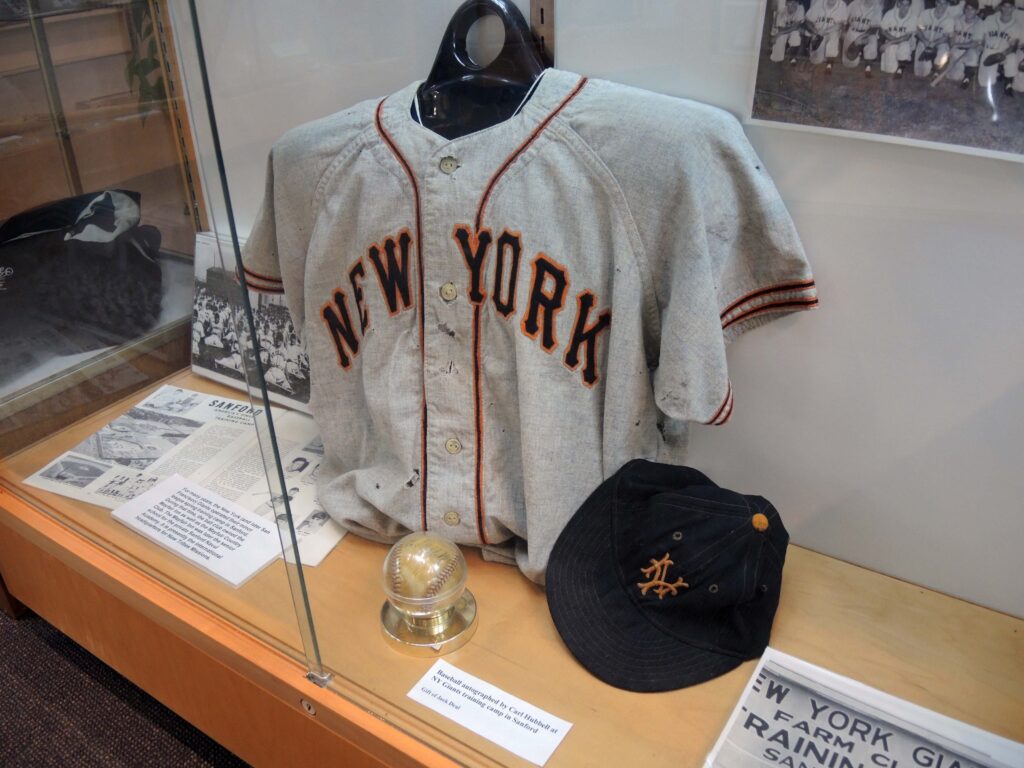
On March 17, 1948, Babe Ruth visited Sanford as part of a promotional tour for Ford Motor Company.

The Sanford Museum includes displays highlighting Babe Ruth Day in Sanford, including pictures of Ruth at the local newspaper office and sitting in the grandstand at Sanford Field. Ruth would pass away just three months later, on August 16, 1948.

The American Association Minneapolis Millers wee one of the Giants affiliates who moved their spring training to Sanford. “Training Sites Are Selected,” Baltimore Sun, January 8, 1949: 13. In 1948, Giants owner Horace Stoneham purchased the Mayfair Hotel to house players, as well as the Mayfair Country Club, to provide recreation for his players and to increase tourism in the area.

Stoneham renovated the hotel, renaming it the Mayfair Inn.

With the onset of the Korean War in 1951, the Navy reclaimed the air station, thereby requiring that the Giants vacate the expansive minor league training camp. The Giants moved operations just a couple miles north to land adjacent to Sanford Field, and in 1951 constructed a new ballpark, Sanford Memorial Stadium.

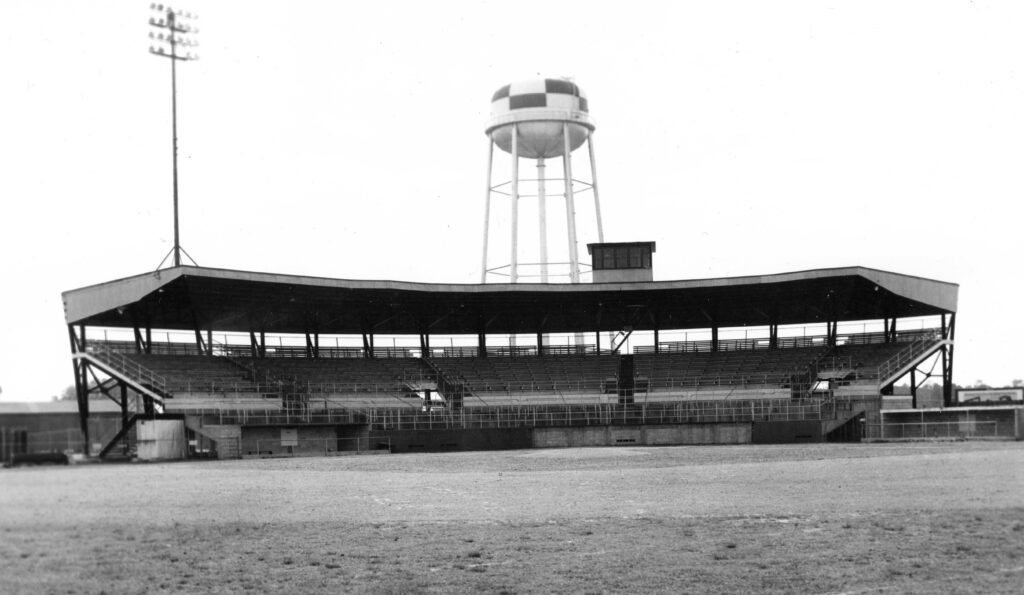
The stadium was “Dedicated To The Memory Of The Men And Women Of Seminole County Who Served Their County In All Wars.”

The Giants also constructed additional practice fields near the stadium. Willie Mays was one of many former Giants who trained as minor leaguers at Sanford Memorial Stadium.

Three of the practice fields were constructed to the east of the stadium, and a fourth field was constructed just southeast of the stadium.

The Giants conducted minor league spring training at Sanford throughout the 1950s. With the major league Giants’ move to San Francisco in 1958, however, the Giants soon wound down their operations in Sanford.
Today, Hamilton Elementary School sits on the former site of three of the Giants’ practice fields.

Located behind Stanford Memorial Stadium is Zinn Beck “Field of Legends” – adjacent to what was once the Giants’ western-most minor league practice field.

Chase Park, located next to the stadium site at 1300 Celery Avenue, includes additional youth baseball fields.

The Herbert H. Whitey Eckstein Youth Sports Complex is named in honor of the father of David and Rick Eckstein, a high school teacher and coach in Sanford.


One of the four baseball fields that make up the Eckstein sports complex – Field Four – is located on the former site of one of the Giants’ minor league practice fields.

In 2001, the City of Sanford renovated Sanford Memorial Stadium, renaming it Historic Sanford Memorial Stadium.
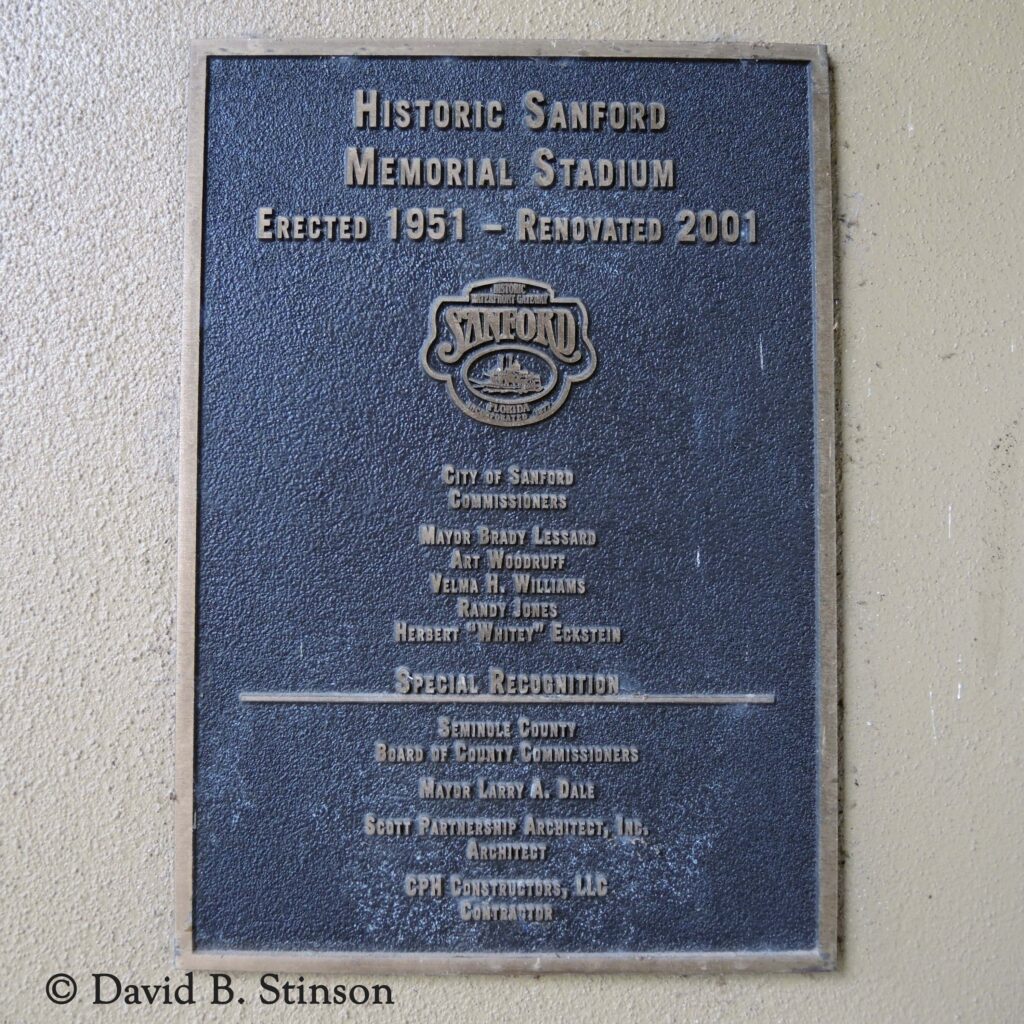
The stadium, however, retains much of its 1950s charm.



In 2009, the Seminole County Naturals of Florida Winter Baseball League played their home games at Historic Sanford Memorial Stadium home. They were the last professional team to call the stadium their home.

Currently, the Florida Collegiate Summer League Sanford River Bats play their home contests at Historic Sanford Memorial Stadium home.



The Sanford Museum is located at 520 East 1st Street, along the shores of the St. John’s River.

In addition to the many displays and photographs noted above, the museum includes memorabilia and photographs of notable Sanford residents who played professional baseball, such as Hall of Famer Andre Dawson.
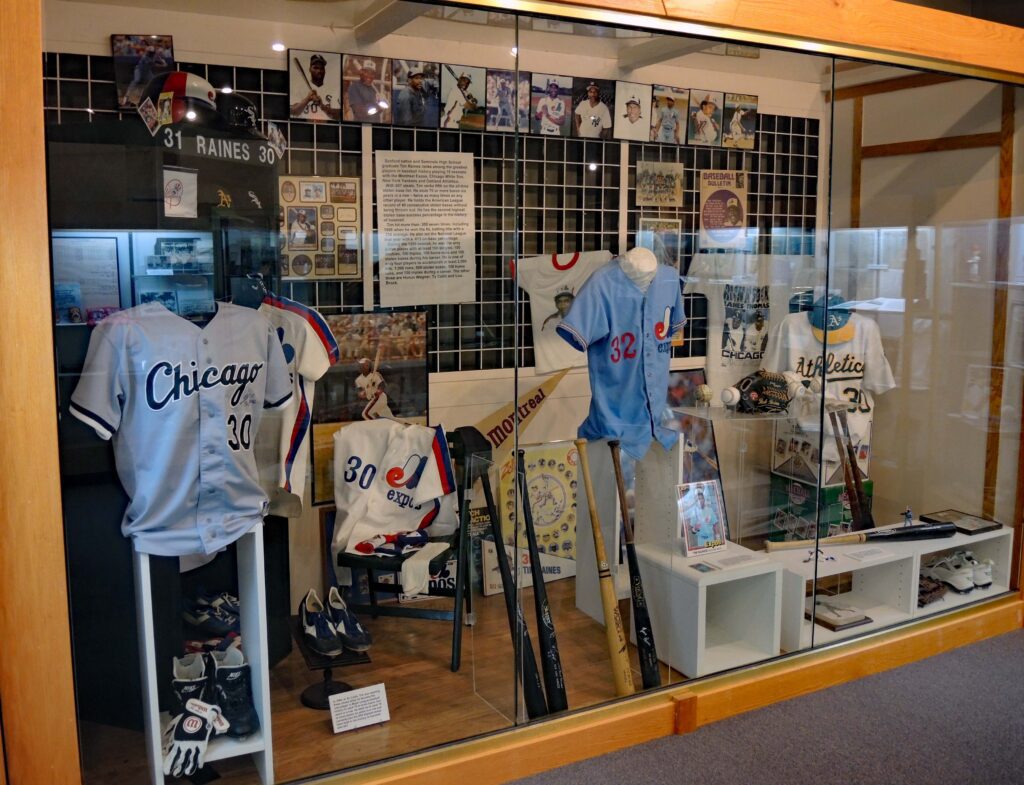
The Eckstein Brothers, David and Rick, grew up in Sanford, and the museum includes a display celebrating David Eckstein’s 2006 World Series exploits.

Sports announcer Walter Lanier “Red” Barber lived in Sanford, beginning at the age of 10. Barber as the voice of the Brooklyn Dodgers during the 1930s and 1940s, suggested to team executives that the Dodgers hold spring training in Sanford.

If you visit Historic Sanford Memorial Stadium, or find yourself in or around Orlando or Daytona Beach, be sure to stop by the Sanford Museum. It is wonderful place to spend an afternoon, lost in baseball history.

